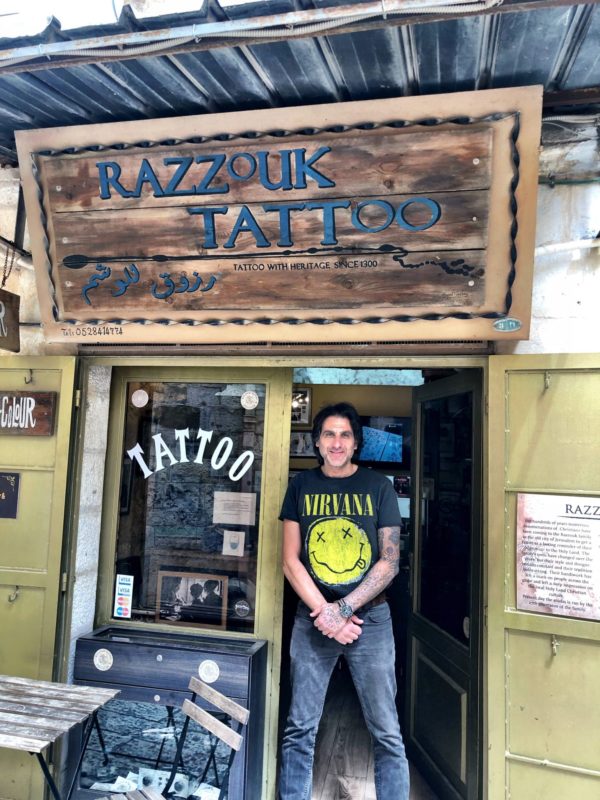Jerusalem Diary
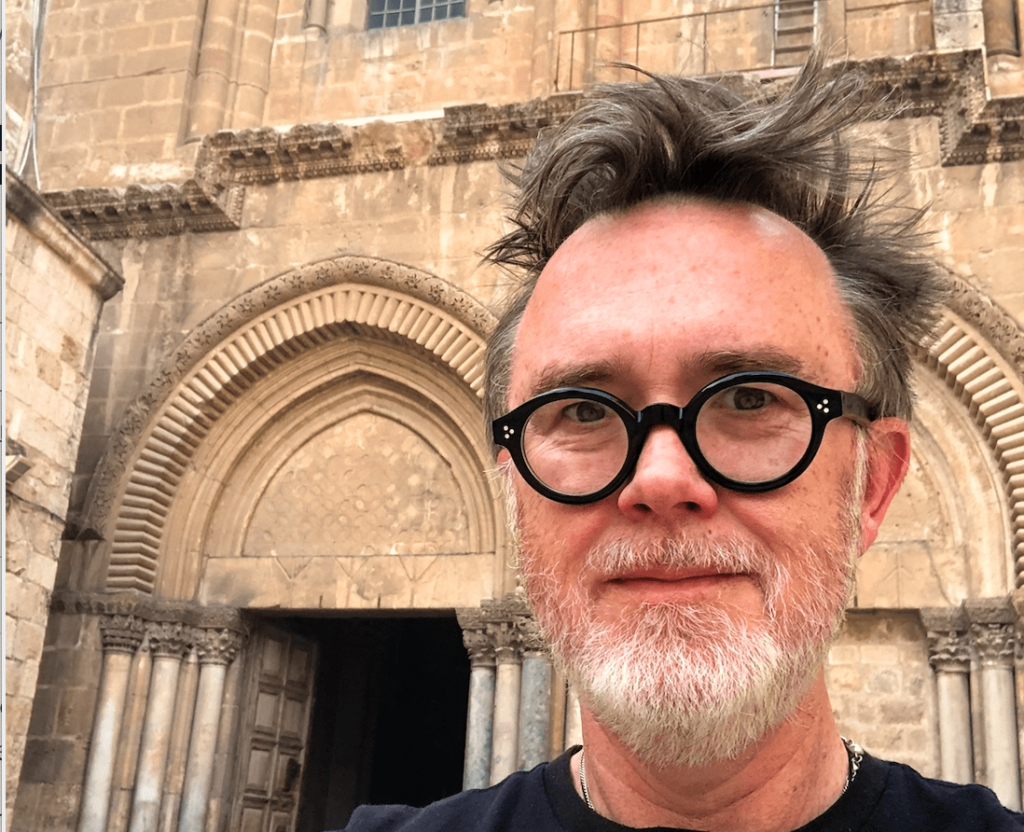
Hello from the Old City of Jerusalem, where I arrived yesterday to spend Orthodox Holy Week. I am here first to pray, but also to gather material for my book on re-enchantment.
After I checked in to my hotel, I sent straight to the Church of the Holy Sepulcher to pray at the chapel over Golgotha. I received some truly grievous news from back home on Saturday morning (sorry, I have to protect the privacy of others), and wanted to rush to pray for those dear to my heart who are suffering. The Golgotha chapel is on the second level of the Holy Sepulcher church. It really is built over the hill where Jesus was crucified. How do we know this? Because the place on which the HS church was built, and where Golgotha was identified, fits the Biblical description of the place of the Crucifixion. And the Romans built a temple to Venus on the site encompassing both Golgotha and what is believed to be Christ’s tomb, which now constitutes the HS church. Why did they do that, given that it was in a strange place outside the city? Some theorize that it was to discourage Christians of the early church from gathering at these places to pray. So when Helena, the mother of Emperor Constantine, came on pilgrimage to the Holy Land, her son’s predecessor on the imperial throne had inadvertently marked the spot.
Here is the altar built over the rocky hillock itself:
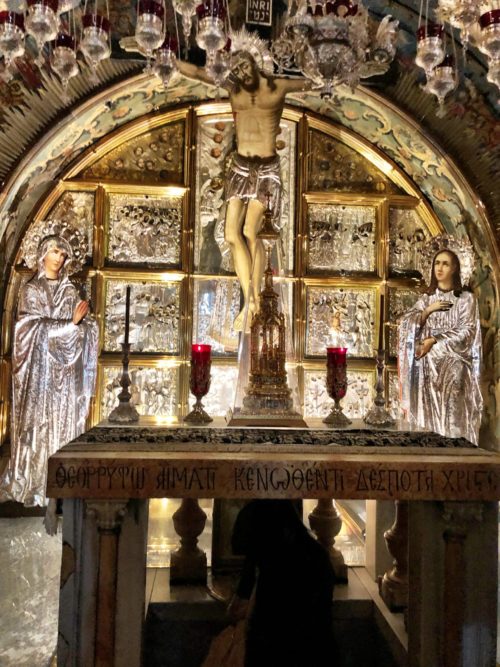
There is a pilgrim under the altar. If you bend down and go underneath the table, you can put your hand through a hole in the floor and touch Golgotha yourself. Here’s what the rock looks like, beneath this glass sheet to the side of the altar:

That was the altar upon which the Lamb Of God Who Takes Away The Sin Of The World was sacrificed.
That rock, and no other. This is what it means to be in Jerusalem.
I prayed half my prayer rope at Golgotha, asking Christ’s mercy on my suffering loved ones. Then I went downstairs to the edicule, the little house built over the spot where Christ’s Tomb was. I prayed the rest of my prayer rope there. It is inside the edicule that the Greek Orthodox Patriarch goes on Holy Saturday for the miracle of the Holy Fire. Orthodox Christians believe that when the Patriarch says prayers in there on Holy Saturday, a mysterious light descends from heaven and lights the candles he holds in his hands.
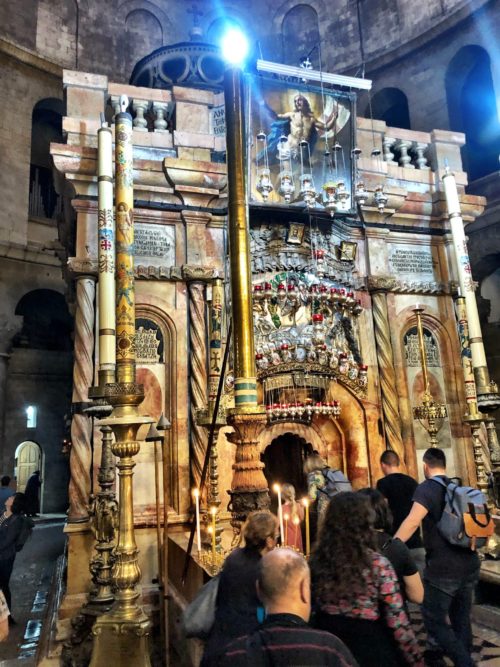
Here, from a website dedicated to the miracle, is a description from a previous Greek Patriarch about what happens:
“I enter the tomb and kneel in holy fear in front of the place where Christ lay after His death and where He rose again from the dead… I find my way through the darkness towards the inner chamber in which I fall on my knees.Miracle of God. At a certain point the light rises and forms a column in which the fire is of a different nature… Here I say certain prayers that have been handed down to us through the centuries and, having said them, I wait. Sometimes I may wait a few minutes, but normally the miracle happens immediately after I have said the prayers. From the core of the very stone on which Jesus lay an indefinable light pours forth. It usually has a blue tint, but the colour may change and take many different hues. It cannot be described in human terms. The light rises out of the stone as mist may rise out of a lake — it almost looks as if the stone is covered by a moist cloud, but it is light.
This light each year behaves differently. Sometimes it covers just the stone, while other times it gives light to the whole sepulchre, so that people who stand outside the tomb and look into it will see it filled with light.
The light does not burn — I have never had my beard burnt in all the sixteen years I have been Patriarch in Jerusalem and have received the Holy Fire. The light is of a different consistency than normal fire that burns in an oil lamp… At a certain point the light rises and forms a column in which the fire is of a different nature, so that I am able to light my candles from it. When I thus have received the flame on my candles, I go out and give the fire first to the Armenian Patriarch and then to the Coptic. Hereafter I give the flame to all people present in the Church.”
In a 2021 interview with L’Osservatore Romano, Patriarch Theophilos said:
The ceremony of the Holy Fire has its origins in the early years of the Church when the liturgical practices of the Church were developed and it is one of the most ancient experiences in our tradition in the Church of Jerusalem. We have evidence of this from the itineraries of early pilgrims, like Egeria. Year after year both local Christians and pilgrims gather for this moment when we have a foretaste of the resurrection, which we call in our tradition the “First Resurrection.” This represents the light that shone from the tomb which the myrrh-bearing women experienced. As we read in the Gospel of Saint Matthew:
After the sabbath, as the first day of the week was dawning, Mary Magdalene and the other Maty went to see the tomb. And suddenly there was a great earthquake; for an angel of the Lord, descending from heaven, came and rolled back the stone and sat on it. His appearance was like lightning, and his clothing white as snow (Mat 28:1-3).
This is an experience of the Uncreated Light that shines from the Holy Tomb and that is symbolised in the lighted candles that spread light not only throughout the church, but throughout the world. In every Orthodox church at the beginning of the Easter liturgy the people come forward to receive the light from a candle held by the priest and this custom came to them from Jerusalem. Even in times of persecution and difficulty for the Church of Jerusalem in ages past, the witness of the Holy Fire has continued.
Some say, of course, that the miracle must be a fraud. We have records of it happening going back to the first centuries of the church, though, back to a time when it was very hard to light a fire (that is, before the creation of matches). Plus, in modern times, the Patriarch is searched by police before he goes into the edicule for the ceremony, to make sure he doesn’t have any ignition sources. Anyway, I will be present this Saturday for the Holy Fire ceremony, and see what I can see with my own eyes.
I found out last night that my friend Father Dwight Longenecker, a US Catholic priest, is in Jerusalem doing Biblical studies. He came over to my hotel this morning, and we had coffee.

Father Dwight’s newest book is called Beheading Hydra: A Radical Plan For Christians In An Atheistic Age, in which he talks about how extremely fringe in history contemporary Western culture is, with our rejection of transcendence. I thought that since here we were in Jerusalem (our last meeting was in Lafayette, Louisiana), I might as well interview him for my book on re-enchantment.
“The divide between what I call the sacramental vision and the modern world began in the 16th century, when Western man basically took the idea — one that not only had been part of Christianity but part of humanity since the beginning — that the invisible realm was integrated into the physical realm,” he said. “For us Catholics and you Orthodox, through the sacraments, through the physical realm, we access the invisible realm.”
Father Dwight said that the theological revolution of the 16th century (the Reformation) led to the Scientific Revolution of the 17th century, which built on the rejection of metaphysics. In the 18th century this led to the Enlightenment, then the Industrial Revolution, and eventually the Sexual Revolution. The Catholic and Orthodox churches still teach the sacramental vision, the priest said, “but so many Catholics today have forgotten it, and are held hostage by the modern age, with its absence of spirituality.”
The priest’s first steps towards the sacramental vision came when he was a student at fundamentalist Protestant Bob Jones University. He became an Anglican, and ended up later at Oxford studying theology, after which he was ordained in the Church of England.
“After that, in 1987, I made a pilgrimage from England to Jerusalem, hitchhiking, and stayed at Benedictine monasteries all across France and Italy. It was a great adventure. I was every day on my own, praying my way to Jerusalem. It was a real immersion into the sacramental vision, into the Catholic life,” he said.
“Of course coming to England from America, it was like I stepped back 500 years, to the Anglican church. But then walking through France, and Italy, and finally Greece and the Holy Land, it was an even deeper immersion in the historic faith.”
“You were literally walking back through history, to the geographical source of Christianity,” I said.
“Yes, in France it was like walking through the Middle Ages,” Father Dwight said. “In one village, I stopped in a medieval church open for prayer. High in the tower there was a carving of a monk, and he was standing with his hands folded over his belly, and his eyes, which were carved larger than life, were closed. He was a picture of the contemplative life – the discipline of your physical appetites, with his hands folded over his belly, but with his closed eyes larger than life, indicating that this is how you really see things.”
When he reached the 8th century Benedictine monastery of Novalesa, on the Italian side of the Alps, he had a jarring experience.
“The monks showed me around a series of little chapels in the monastery grounds,” he began. “‘And this chapel,’ a monk said, ‘was built on the foundation of a chapel established by St. Paul.’ And I’m like, get out! I’m an American! You must be kidding me. And then I remembered that the Book of Acts says that St. Paul went to the uttermost parts of the West. Certainly he came to Rome. He could have gone to northern Italy. And of course Rome, with the relics of St. Peter and St. Paul, but that didn’t really register with me at the time. In Greece you see road signs to Thessalonika, to Ephesus. It’s overwhelming.”
I tell my friend how shocked I was the first time I was in Jerusalem, in the year 2000, to encounter all these places and names that I had grown up with in Southern Christian culture. They were real. It’s such a strange and wonderful feeling.
“The ‘myth’ of the Gospels, which have been demythologized by the liberal scholars – actually, you come to Jerusalem, to the Holy Land, and you realize that it’s not a myth,” said Father Dwight. “That it really happened here. That’s why they call the Holy Land ‘the fifth Gospel’.”
We have to lean hard into beauty to re-evangelize the world today, said the Catholic priest.
“We built a beautiful new church in my parish in South Carolina,” he said. “We built it in a typical Romanesque style. We salvaged stained glass windows from a church that was closing in Massachusetts. One of the amazing things about our church is that anybody who steps back into the nave immediately falls silent, and says, ‘It’s beautiful.’ These are schoolchildren, people with PhDs in art history, plumbers, electricians, everybody. The apprehension of beauty is universal.”
Father Dwight, 65, is on sabbatical in Jerusalem living with the Dominican fathers at the École Biblique. He said that being here now, as an older man and indeed a Catholic priest, opens the holy city’s meaning up to him even more.
“Yesterday, as a Catholic priest, I concelebrated Mass with the Latin Patriarch at the Catholic-controlled area of the Church of the Holy Sepulcher, which is the chapel of St. Mary Magdalene,” he said. “So I was standing virtually at the place where St. Mary Magdalene met the risen Lord on Easter morning. It’s just phenomenal.
“On Palm Sunday, thousands of us walked down the Mount of Olives into Jerusalem. On Holy Thursday, we met in the Church of All Nations, which was packed, for a prayer service, in the Garden of Gethsemane. And then there was a torchlit prayer procession down the Kidron Valley and up to the Church of St. Peter in Gallicantu, which was where Jesus was tried before the Sanhedrin.”
I told him that the first time I visited the Garden of Gethsemane, and gazed across the Kidron Valley up at the Old City of Jerusalem, it hit me for the first time that it really was a mountain of sacrifice — an altar. I might have understood that in the abstract, but there was nothing like being in Gethsemane, looking out at the very path Jesus took when then Romans arrested him and took him into custody — it’s overwhelming.
Father Dwight began talking about the tragedy of how modern Catholics have lost so much of the mystical spirit inherent to their faith.
“It saddens me that we have sacrificed all this mysticism for relevant practicality – like, how can we be nicer people in the world?” he said. “Of course we need to feed the hungry and house the homeless, and work to make the world a better place. But this is a consequence of our faith. It’s not the faith. It’s what Christians do; it’s not what Christians are. The liturgy is what we are. We are supposed to be there in body, mind, and spirit in the love and worship of God, and the liturgy is how we make that connection. That’s what gives us the power to do that other stuff in the world. If we reduce it all to Girl Scouts selling cookies, we do ourselves a great disservice.
“And this is why churches are emptying,” he continued. “People go to church and find out that it’s no more than the Rotary Club at prayer, and they say, ‘I don’t need to go to church to be a good person’ – and they’re absolutely right.”
“Some of the [Catholic] Traditionalists say that it was because the liturgy was debased,” the priest continues. “I say uh-uh, it goes way deeper than that. The problem is a crisis in belief in historic Christianity. The liturgy being debased is a symptom of that.”
We said goodbye so I could go meet the Greek Patriarch, Theophilos, the unbroken successor of St. James, the first bishop of Jerusalem.
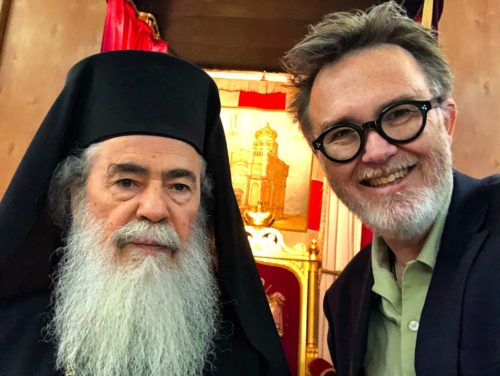
Of course I asked him about the Holy Fire, as he is the one who receives it. He was clearly weary of talking about that subject with a journalist, and referred me to the L’Osservatore Romano interview I quoted above. The Patriarch went on to say:
The thing is that the Holy Land is the land of the human-divine encounter, correct? Which means this part of the earth has the unique privilege to have been blessed, and therefore sanctified, by the blood of the Righteous One, Our Lord Jesus Christ. So it is the blood of Jesus Christ that has made this place to be holy. Which means to be a place where divine energy emanates from. This is what makes Jerusalem specifically to be a place of purpose for every human being who visits this part of the earth. I’ve been here for 68 years, and my experience is that I have not seen so far anyone who left Jerusalem without being touched. You can’t remain indifferent.
Inside the Tomb of Jesus Christ is full of energy. This has been confirmed and verified not by myself, but by the engineers and architects who were in charge with the restoration of the Edicule of the Holy Tomb. You can see it in the National Geographic narrative. The narrative of the Holy Tomb is that it is full of energy. When the architects and specialists were about to remove the marble to discover the tomb, they put very special instruments there, in order to measure the quantity of energy, all those sensitive instruments were totally destroyed.
I didn’t find that information in the National Geographic article, but I did find it in a 2016 report in Aleteia. Excerpt:
But the journalist is much less hesitant regarding the electromagnetic disturbances recorded by the scientists’ instruments. The phenomenon was confirmed by one of the scientists authorized to access the tomb. Later, one of the heads of the building and construction team, Antonia Moropoulou, indicated that it is really hard to imagine that someone would be willing to put in danger his or her reputation just because of a “publicity stunt.” Moreover, the journalist testifies to the scientists’ surprise during the opening of the slab: they hoped that the grave would be much lower than it was. Their conclusion: previously performed analyses with the instruments seemed to have been distorted by an electromagnetic disturbance.
It seems, lacking any other explanatory element, the tomb of Christ indeed affected instruments sensitive to electromagnetic disturbances.
This Catholic website speculated:
The observation of these unusual electromagnetic anomalies at the tomb of Jesus may lend credence to a scientific hypothesis on the creation of the ghostly image on the Shroud of Turin. Italy’s National Agency for New Technologies, Energy and Sustainable Economic Development [ENEA] concluded during a five-year-long study that the Shroud of Turin could not be a ‘medieval fake’. The findings of ENEA study hypothesized that the image may have been created by an intense source of light, stronger than could be created by any technology currently available to man. The results of ENEA “show that a short and intense burst of VUV directional radiation can color a linen cloth so as to reproduce many of the peculiar characteristics of the body image on the Shroud of Turin, including shades of color, the surface color of the fibrils of the outer linen fabric, and the absence of fluorescence”.
The study noted “that the total power of VUV radiations required to instantly color the surface of linen that corresponds to a human of average height, body surface area equal to = 2000 MW/cm2 17000 cm2 = 34 thousand billion watts makes it impractical today to reproduce the entire Shroud image using a single laser excimer, since this power cannot be produced by any VUV light source built to date (the most powerful available on the market come to several billion watts )”.
Back to my talk with the Patriarch, who spoke of the special view that the Orthodox Church brings to Christianity. He talked of the purity of the Orthodox approach, not endeavoring to explain mystery, but rather to accept it and to live it out:
The Orthodox Church is represented by the Greek mind — not the Greeks, please! but the Greek mind — and you know, the Greek mind has two ways of thinking. One is the mind of inventiveness, which means speculation; and the other is revelation. So the Greek [Orthodox] mind gave up inventiveness, which implies idolatry of human inventiveness. When the Greek mind met with the prophetic divine, it endorsed the prophetic divine. Sacred history — the history of revelation — is taken seriously.
In the Orthodox Church, there is nothing that is not substantiated in the Bible, in the history of revelation. If you take all the great Church fathers and Orthodox saints, they say nothing that is not established in the Bible. What the Church fathers do is try to understand the Bible. This is why there is a very special word in Greek. It is said that the Church fathers do not ‘invent’. Rather, they go all around [what already exists].
So, in order to understand the mystery of God is to go through a three-stage process. One is purification. The next is illumination. And the final stage is deification (theosis). This is what the Orthodox Church is all about. The sacraments of our church are helping us to purify ourselves, to clean ourselves so the Holy Spirit will dwell within us. Then enlightenment comes. This is why the great fathers of the church became luminaries.
The Patriarch went on to say that today, scientists are discovering things that validate observations made during the Patristic era by Basil the Great, Gregory of Nyssa, John Chrysostom, and other Church fathers. I have been reading a bit about that this spring, in fact, and will need to go more deeply into it.
The Patriarch gave me two icons, a hand cross, and a prayer rope — but the greatest gift was of his time, on what for him is the busiest week of the year.
After that meeting, I headed back over to the Church of the Holy Sepulcher, and had another look around. I saw in the Catholikon (the central part of the crazy-quilt church), an odd structure. Look:
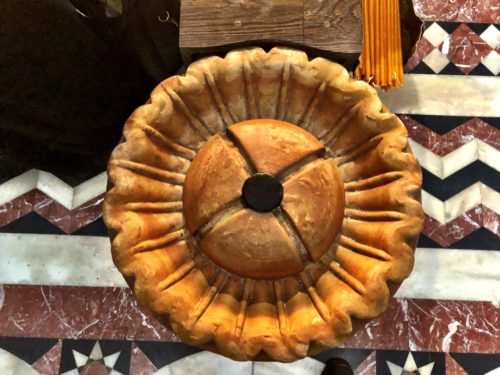
Is that a delicious Cornish pastie? No, it’s an omphalos, or navel, stone, marking the center of the world. It is exactly halfway between Golgotha and the Tomb of the Resurrection. That is, at precisely the midpoint of the two sites on this earth where the eternal cosmic destiny of humankind was worked out.

If you stand near the omphalos stone and look up into the dome of the church, this is who you see:

Christos Pantokrator — Christ, the Ruler of All, the God-Man, looking down on the site of his death and resurrection.
There, in that church. In this city. Nowhere else in the world.
It’s almost too much to take in.
At the omphalos stone I fell into conversation with a Palestinian Christian, who, as it turns out, is Orthodox. Most Palestinian Christians are. I enjoyed talking to her about Christian life in the Holy City, and ended up inviting her to lunch. It turns out that she had done graduate work in the United States, at an elite institution, and had not been favorably impressed. I won’t quote her directly because it wasn’t an interview, but she basically said that she was struck very hard by the cluelessness of her fellow American students. They didn’t know anything about the world beyond their own, and they were impossible to educate, because they thought they knew it all. She said she ended up getting really mad at them sometimes, because America is so powerful in the world, and affects her world in particular. But we just stumble through the world ignorantly, and can’t understand why people hate us.
A second thing that she took from her time in America is how insane it is over what we call “wokeness” (she knew the word). She said that it was absolutely shocking to her, as a Palestinian, to have to deal with LGBT ideology in US academia. She said it was not only shocking in itself, but the inability to say anything critical about it really knocked her for a loop. She learned very quickly to keep her mouth shut about what she really believed. She did not fail to notice that her fellow students prided themselves on being supremely open-minded and tolerant, but instead she found them to be rich, culturally illiterate liberal bumpkins.
She talked further about how resentful her people are of US cultural imperialism, by which she meant the spread of LGBT ideology. I mentioned to her that it is very hard for conservative Americans like me to accept that our country, which we love, has now become responsible for bringing so much corruption into the world.
“This is new for you, maybe, but we have always seen you Americans that way,” she said sharply. “Sorry, I’m very direct.”
I thanked her for her honesty.
When we parted, I went over to see Wassim Razzouk at his tattoo shop in the Old City. Maybe you read about it in The New York Times the other day. Excerpts:
But during Holy Week and the days leading up to it, Wassim Razzouk’s tattoo parlor in Jerusalem’s Old City is packed with some of his most reliable customers: Easter visitors who, seeking an indelible reminder of their time in Jerusalem, “want a tattoo as a certificate of pilgrimage,” Mr. Razzouk said.
More:
While tattoos may have moved into the global mainstream only in the last few decades, the Razzouk family has been practicing the art form a little bit longer: 700 years, or 27 generations, he said. He’s the scion of a long-venerated family of tattoo artists, Coptic Christians who, as family lore has it, came on a pilgrimage from Egypt to the Holy Land hundreds of years ago, and decided to stay in Jerusalem and set up shop.
Mr. Razzouk — with his long hair, Harley-Davidson biker’s jacket and passion for motorcycles — decided to follow in the family tradition at the age of 33. His two sisters and the cousins of his generation were not interested in becoming tattoo artists, he said, adding, “I knew that if it wasn’t for me the tradition would disappear.”
His father, Anton, 82, taught him the craft, having learned it from his father, Jacob, or Yaqoub.
Here’s a link to a short film clip about Wassim and his work.
I went to see Wassim because I was interested in the phenomenon of why certain religious pilgrims feel the need to mark their visit to the Holy City with a tattoo. We had a great interview, but honestly, it’s 1:25 am here in Jerusalem, and I’m too tired to transcribe it now. I will tell you, though, that I decided to get a tattoo. I am no fan of tattoo culture, but there is no other city like Jerusalem, and no other place like Razzouk’s. Besides, standing at the site of Christ’s death on the Cross the night before, and praying for my loved ones caught up in this terrible situation back home, I found that I wanted somehow to feel in my skin, for all the days left of my life, the truth that JESUS CHRIST CONQUERS. That nothing we have to suffer today is the final word. That the Lion of the Tribe of Judah, the Root of David has triumphed.
So I chose the medieval Greek cross with the symbols that mean IX (Jesus) XC (Christ) NIKA (Conquers):
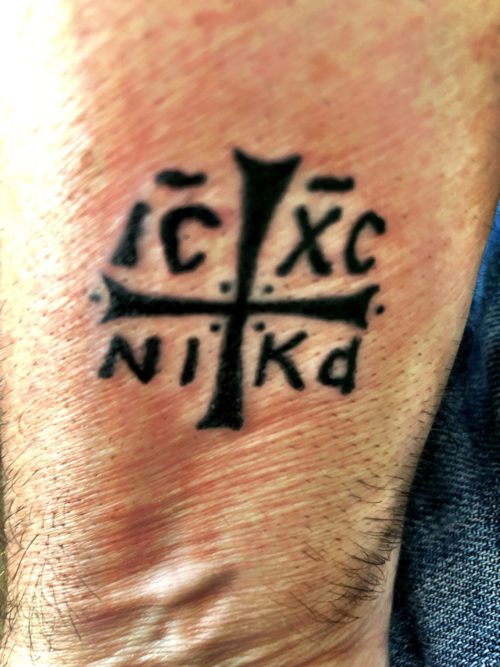
Wassim and me, in a selfie:
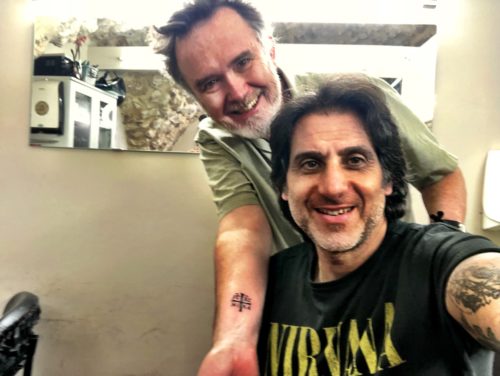
Next time you’re in Jerusalem, go see Wassim at Razzouk Tattoo. You’ll have a great conversation with him, and his work is varied and beautiful. He’s known for tattoos made from Coptic stamps hundreds of years old, that had been passed down by his family. They were quite striking, but as I am a middle-aged fogey, I decided to have my one and only tattoo be something more modest, and personally meaningful to me.
